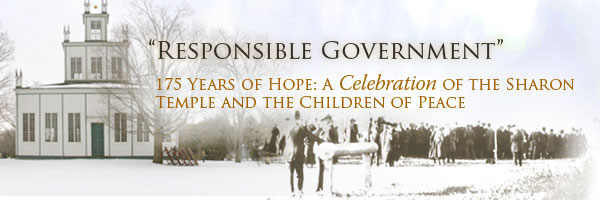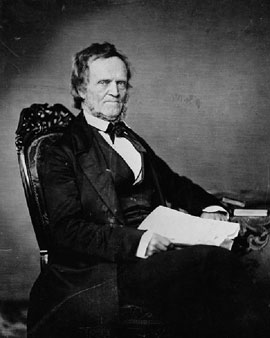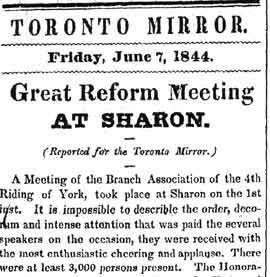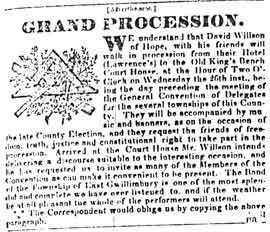
Table of Contents

William Lyon Mackenzie
Reference Code: S 2123
Archives of Ontario
The Children of Peace were as interested in political as in economic justice, and so quickly formed links with Toronto reformers such as William Lyon Mackenzie.
When Tory political violence at public meetings threatened to shut down debate, these reformers rented their own “radical hall” with the Children of Peace. A small notice in the Advocate of Oct. 17th, 1833 announced that the Old Court House could now comfortably seat 400 people. And in the same issue, the Children of Peace announced they would hold a meeting for worship there the next Sunday. The Children of Peace collectively declared in the Advocate soon thereafter, that:
rights as having part in the care of the province, and to
use our humble exertions to appoint just men to
government, and without an influenced vote choose for
ourselves who shall rule over us.”
William Lyon Mackenzie, newspaper editor, elected member of the legislature, and first mayor of Toronto, also led a rebellion against British rule in 1837
Given the general fear within reform circles of the day, the Children of Peace collectively stand out as courageous advocates for Mackenzie. Mackenzie, in turn, lauded the group.
[Return to top of page]
David Willson was also the inspiration behind the “Grand Convention of Delegates” in 1834 to nominate reform candidates for the next election. Willson offered fatherly advice on how to conduct such a new and innovative institution in the Advocate, emphasizing the importance of establishing a permanent and regular convention.
Although the Grand Convention was little more than a centralization of the local process for nominating candidates, their emphasis on local control of representatives was balanced by the collective process of defining a platform to which the local candidates had to agree. It is thus within this convention that we see the germs of a reform “party”, a “permanent convention.”
The convention was convened for the 27th of February, 1834. The day before the convention, the Children of Peace again held a “Grand Procession” to the old Court House. Willson addressed the delegates and “pray[ed] for a standing convention,” a party organization, so that they could,
are well concerted, and then bring them to the light, far
and wide as your care extends. In so doing, you will hide
yourself from the battle till you are armed, and save
your heads from public censure, and your weakness
from the archers eye.”
This advertisement, and many more from Mackenzie’s earlier newspaper, the Advocate, recorded the frequent processions and political action taken by the Children of Peace in aid of democratic reform.
As a result of this convention the reformers swept the next elections in Toronto and York County.
The next year the convention became a more permanent organization with the founding of the Canadian Alliance Society. It is important to underscore the economic factors that brought these disparate groups of reformers together.
By 1835, the province was in economic crisis, and the economic ills that had pushed the farmers of the Home District to form the Farmers’ Storehouse became acute. The first petition circulated by this new alliance was for a “Provincial Loan Office” on the model of the Charity Fund of the Children of Peace, and the Farmers’ Store House Bank.
[Return to top of page]
![Print: The Honourable Robert Baldwin, [ca. 1840]](pics/robert_baldwin_270.jpg)
Click to see a larger image (72K)
The Honourable Robert Baldwin, [ca. 1840]
Documentary art collection
Reference Code: C 281-0-0-0-144
Archives of Ontario, I0003075
Although the reform movement was set back by rebellion in 1837, the Children of Peace were undaunted and continued to support the cause. In particular, they threw their weight behind both Robert Baldwin and Louis LaFontaine, the “fathers of responsible government.”
Baldwin ran for election in the 4th Riding of York when government sponsored political violence in Toronto made election there impossible. The Children of Peace organized a “Union Society” to ensure Baldwin was elected in 1841. This society’s name referred to the wider “union of the Canadas” that the British were imposing on Upper and Lower Canada in an effort to swamp French Canadians within an English speaking majority.
Baldwin was elected in two ridings, and stood down in 4th York to allow LaFontaine to run there, after LaFontaine lost in his Quebec riding due to political violence. The Children of Peace used their ”Illumination“ of the Temple to great effect in electioneering for LaFontaine. They proudly proclaimed an alternate vision of the “union of the Canadas“: Willson proclaimed

Click to see a larger image (160K) see a larger image (160K)
Great Reform Meeting at Sharon
Toronto Mirror, 7 June 1844
One of the first actions of the electors of LaFontaine’s Quebec riding of Terrebonne was to send a vote of thanks to the electors of the 4th Riding. The election of LaFontaine in 4th York had the effect desired by Baldwin in uniting the French party under LaFontaine, and unifying them with the smaller group of radical reformers in Upper Canada. Critically, it was the electors of both the 4th Riding of York, and of Terrebonne, who sought to remind their representatives of the significance of their votes.
The address from the electors of Terrebonne lauded the constituents of the 4th Riding for their lack of “national prejudice” and for “having no view but one aim, the confraternity of both populations.” - Mirror, December 31, 1841.
The 4th Riding responded that they had been “deeply impressed with horror at a perversion of authority, which employs might for the subversion of right.” They were “impelled by a sense of duty, to mark, in the strongest manner, our disapprobation of the scenes of blood and disorder, which had been enacted at the Elections in Canada East.” They hoped “to break down the partition wall of prejudice, by holding out to our fellow subjects of French origin, the right hand of friendship, in electing to represent us, one of their tried and ablest defenders.” - Mirror, February 18, 1842.
The supposed “deadly animosity” between French and English had proven ephemeral, as they overcame differences of language, culture, religion and distance to unite under the principles of equal rights, the local nomination of representatives, and responsible government.
[Return to top of page]
